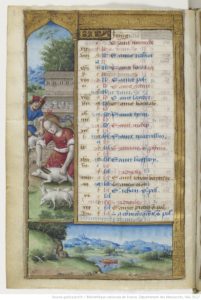
“June”, kalendar page from Les Petites Heures d’Anne de Bretagne (The Little Hours of Queen Anne of Bretagne), by the Maître des Triomphes de Pétrarque. From Bibliothèque nationale de France, Paris (France).
Finally he found a teacher who was just right—and not even a teacher, really, just an old Syrian Christian. He converted, possibly in Ephesus, and then headed to Rome, where he started his own school. During the reign of Marcus Aurelius, Justin was denounced by a Cynic philosopher (he wasn’t snarky, he belonged to a school of philosophers called Cynics) and beheaded.
The location of Justin’s relics is the subject of some contention. The church of St John the Baptist in Sacrofano, just north of Rome, claims to have his relics, but so does the church of the Jesuits, in Valletta, Malta. But there’s also a New World contender. A noble family in Italy purportedly was concerned about the safety of the saint’s relics during a period of unrest in Italy (not an infrequent occurrence), so in 1873 they sent them to a priest in Baltimore for safekeeping. They were displayed in St Mary’s church in Annapolis for a while, and then locked away. In 1989 they were rediscovered and given a proper burial at St mary’s, with the approval of the Vatican.
Justin was an important author, although only a few of his works survive. He is particularly regarded for his defense of the morality of Christian life, and he argued that the “seeds of Christianity” (manifestations of the Logos) predated Christ’s incarnation. This line of argument allowed him to claim ancient Greek philosophers such as Socartes and Plato as “unknowing Christians”.
Uniquely among martyrs, Justin is accorded the name “Martyr” as a surname: he is Justin Martyr, not Justin the Martyr. When Pope Leo XIII added Justin to the kalendar, he set the date as April 14, one day after his death as recorded in the Martyrology of Florus. In 1968, his commemoration was moved to June 1 in order to move it safely out of Paschaltide. June 1 is the date on which he has been celebrated in the Byzantine Rite since at least the 9th century.


